They were the King and Queen of Film Noir: Humphrey DeForest Bogart and Lauren “Betty” Bacall. He was insolent and tough; she was insolent and beautiful, and they made dark, wonderful, wise-cracking music together – in a noir world of shadowy streets, nightclubs, guns, crooks, cops, cigarettes, whiskey, trench coats (for him) and evening gowns (for her).
The Noir File: The Great Film Noir Couple: Bogart and Bacall
They were the King and Queen of Film Noir: Humphrey DeForest Bogart and Lauren “Betty” Bacall. He was insolent and tough; she was insolent and beautiful, and they made dark, wonderful, wise-cracking music together – in a noir world of shadowy streets, nightclubs, guns, crooks, cops, cigarettes, whiskey, trench coats (for him) and evening gowns (for her).
‘The Big Sleep’ and more on the big screen
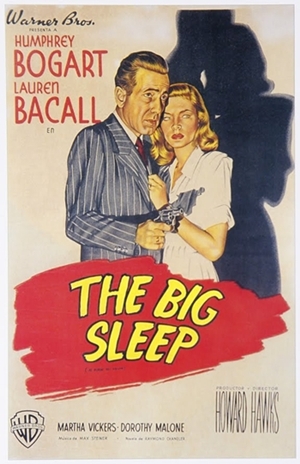 Tonight (Wednesday, June 13) at 8 p.m., the Film Noir Foundation’s Alan K. Rode will host a screening of “The Big Sleep” (1946, Howard Hawks) at the Los Angeles Theatre in downtown Los Angeles. Hawks’ adaptation of Raymond Chandler’s labyrinthine mystery stars Humphrey Bogart as private eye Philip Marlowe and Lauren Bacall as a rich girl who may be helping or hindering him.
Tonight (Wednesday, June 13) at 8 p.m., the Film Noir Foundation’s Alan K. Rode will host a screening of “The Big Sleep” (1946, Howard Hawks) at the Los Angeles Theatre in downtown Los Angeles. Hawks’ adaptation of Raymond Chandler’s labyrinthine mystery stars Humphrey Bogart as private eye Philip Marlowe and Lauren Bacall as a rich girl who may be helping or hindering him.
The event is sold out, but there will be rush tickets available on a first-come first-serve basis at the box office. For more info on the screening, visit the Los Angeles Conservancy.
Additionally, the Pacific Film Archive, in Berkeley, Calif., is hosting One-Two Punch: Pulp Writers, a film series that explores movie adaptations of three divergent authors: Dorothy B. Hughes, Mickey Spillane and Elmore Leonard. The series comprises classic films noirs such as Nicholas Ray’s “In a Lonely Place” (1950) and George A. White’s “My Gun is Quick” (1957), as well as thrillers like Roy Rowland’s “The Girl Hunters” (1963), starring Spillane as Mike Hammer.
For full details about the series, running June 23-30, visit the Pacific Film Archive.
And on Thursday, the Los Angeles Film Festival begins downtown.
Santa Monica shows its dark side at NoirFest
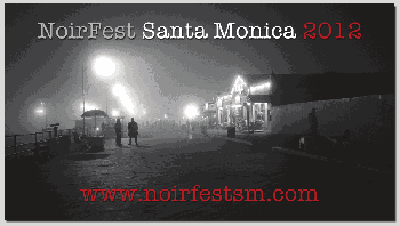 “Farewell, My Lovely” screens Wednesday, Jan. 25, as part of NoirFest Santa Monica.
“Farewell, My Lovely” screens Wednesday, Jan. 25, as part of NoirFest Santa Monica.
The newly launched festival includes art, film, photography, literature, music and spoken-word events. NoirFest runs through March 28.
Other films to be screened include: “The Brasher Doubloon,” “Murder, My Sweet,” “Double Indemnity,” “The Big Sleep,” “Strangers on a Train,” “The Lady in the Lake” and “The Long Goodbye.”
The fest is the brainchild of longtime Santa Monica resident and artist Helen K. Garber, whose solo show “Encaustic Noir” runs through Feb. 25 at Bergamot Station Arts Center, 2525 Michigan Ave. Also on display is vintage night photography by famed Parisian photographer Brassaï and several of his contemporaries.
“Farewell My Lovely” screens at 7:30 p.m. Wednesday at Vidiots Annex, 302 Pico Blvd., Santa Monica 90405. There is a pre-screening reception at 7:00 p.m. Seating is limited to 35; rsvp essential: vidiots@labridge.com.
Free stuff from FNB: Win four Bogie and Bacall movies!
I have a great Christmas-bonus giveaway this month: The Bogie & Bacall Signature Collection DVD set. The set includes these thriller/film-noir classics from the 1940s:
“To Have and Have Not,” 1944, by director Howard Hawks
“The Big Sleep,” 1946, Howard Hawks
“Dark Passage,” 1947, Delmer Daves
“Key Largo,” 1948, John Huston
(Anita is the winner of the November reader giveaway, Criterion’s DVD edition of “The Killers.” Congrats to Anita and thanks to all who entered!)
To enter the December giveaway, just leave a comment on any FNB post from Dec. 1-31. The winner will be randomly selected at the end of the month and announced in early January. Include your email address in your comment so that I can notify you if you win. Your email will not be shared.
Far out: ‘The Long Goodbye’ stretches the lingo of film noir
The Long Goodbye/1973/United Artists/112 min.
One of the best films of the ’70s or an ugly, boring travesty of a well respected detective novel?
Decide for yourself as you watch Robert Altman’s 1973 movie of “The Long Goodbye,” by Raymond Chandler. The film, starring Elliott Gould as private investigator Philip Marlowe, divided critics, earning the above-mentioned rave from Time Out and the snooty slam from Leslie Halliwell.
It was primarily Gould’s free-wheeling interpretation of the beloved PI that drew ire. Charles Champlin called him an “untidy, unshaven, semi-literate dimwit slob.”
An entertaining yarn, soaked in ’70s atmosphere, the movie captures the sunny, scruffy, solipsistic mood and look of Malibu, Calif., at the start of the Me Decade. Marlowe’s next door neighbors, for example, are pot-brownie-baking, clothing-optional candlemakers. We only see them from a distance but in a way they are timeless party girls, a ’70s version of “The Girls Next Door.”
And “The Long Goodbye” stretches the vocabulary of film noir. As Foster Hirsch, author of “Detours and Lost Highways: A Map of Neo Noir,” writes: “For all its self-indulgence and contradiction – the film both satirizes and seeks acceptance as a cool, contemporary L.A. mystery story – Altman’s ‘new age’ noir suggested the genre’s elasticity at a time when it was considered passé. Produced before nouveau noir had taken root, ‘The Long Goodbye’ anticipates the full-force genre revival of the 1980s and 1990s.”
We meet Marlowe late one night as he’s trying to round up food for his hungry cat (Morris the Cat in the role that launched him to stardom). The story spices up when Marlowe’s friend Terry Lennox (Jim Bouton) asks him, after a marital spat, to drive him to Tijuana.
Marlowe doesn’t have much else going on (besides cat care, of course) and so they make the trip; Marlowe heads back on his own to find that Lennox’s wife is dead. The police press Marlowe for info on Terry’s whereabouts, hoping that a little jail time will jog his memory (David Carradine plays Marlowe’s cellmate). They ease up after Terry Lennox commits suicide, having first written a letter confessing to the murder.
Marlowe’s not buying the suicide, but turns his attention to a new client. The sun-kissed and sophisticated Eileen Wade (Nina van Pallandt) wants Marlowe to find her missing hubby Roger Wade, a boozy writer, (played by the wonderful Sterling Hayden, a veteran of film noirs like “Asphalt Jungle” and “The Killing”).
Searching for Roger isn’t all that challenging, but Marlowe has his hands full with a visit from psychopathic gangster Marty Augustine (director Mark Rydell) and his hoods (including young Arnold Schwarzenegger). They’re sniffing around for a load of cash that Terry Lennox was supposed to deliver to Mexico. Surprise, surprise, the cash never made it. So the surly, anti-social Marlowe plods on toward the truth, trying not to get any sand on the shag carpets. [Read more…]
8mm sizzles with noir-tinged rock: Friday at the Roxy
FNB: Any femmes fatales that stand out for you?
JB: Hahaha, are you gonna ask any questions with short answers? Where to start … Marlene Dietrich, Bette Davis, Marilyn Monroe, Gene Tierney, Lauren Bacall, Joan Crawford, Anne Baxter, Nora Zehetner in “Brick” does a wonderful job, not to mention (I know they’re not femmes fatales, but I would be remiss to leave the men out) Joseph Gordon-Levitt gives Bogey a run for his money in that film. And for the men, of course, there is the one and only Humphrey Bogart.
FNB: Of ’40s and ’50s singers or bands, who are your top favorites?
JB: Nat King Cole, Frank Sinatra, Billie Holiday, Edith Piaf, Bing Crosby, to name a few.
FNB: Do you essentially get into character when you perform, especially Juliette as the frontwoman?
JB: In a sense, yes, and it varies from song to song, because each one is a different story, character, sort of mini movie for us. I’m a storyteller not a character (like a GaGa or Madonna), so the approach is a little different. It only takes a note or two for me “see it” in my head again, to step into “her” shoes … from there it’s just natural.
You kind of have to use your whole body to tell the story, and the story becomes my own for that time.
FNB: Raymond Chandler said a good story cannot be devised; it has to be distilled. Do you think that’s true for writing songs and music?
JB: Certainly at times … what Sean plays makes me see stories, so I suppose you could say that is a bit of a distilling process to bring the story down into its key emotional components for a 3 minute song. However, there are other times when you get a “cosmic FedEx” (a term we’re stealing from Scott Russo of Unwritten Law). That’s where the song comes to you almost writing itself and you have to grab and get it down before it moves on. You know, the muse will find another host if you aren’t paying attention.
‘D.O.A.’ reveals the ultimate inspiration to solve a murder: when it’s your own
D.O.A./1950/United Artists/83 min.
“I don’t think you fully understand, Bigelow,” says a doctor to his shocked patient, “you’ve been murdered.”
This is the premise for 1950’s “D.O.A.,” directed by Rudolph Maté, a classic noir about a standup, solid guy from Banning, Calif., named Frank Bigelow (Edmond O’Brien) who, while on a trip to San Francisco, learns he has been poisoned with a time-released fatal toxin. He has just a few days to find his murderer. And here he thought it was just a hangover.It’s particularly bad luck because Bigelow hasn’t served time, he doesn’t play the horses, he’s not eyeing easy money. He is a self-employed accountant in a small town near Palm Springs minding his own business. True, he does like hard liquor, is a bit of a skirt chaser and he’s on the fence about committing to doting girlfriend Paula Gibson (Pamela Britton), but those are minor flaws in the noir scheme of things.
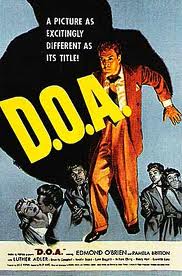 Even though Bigelow is dying, his genetic tough-guy instinct kicks as he abandons his ledger book and adding machine to follow clues, talk tough, tote a gun and chase his prey. Clearly, he missed his calling as a macho gumshoe who could give Phillip Marlowe or Sam Spade a run for their money.
Even though Bigelow is dying, his genetic tough-guy instinct kicks as he abandons his ledger book and adding machine to follow clues, talk tough, tote a gun and chase his prey. Clearly, he missed his calling as a macho gumshoe who could give Phillip Marlowe or Sam Spade a run for their money.
Checking in via phone calls to Paula, who also happens to be his secretary, he learns that a Mr. Phillips, an importer-exporter in Los Angeles, has been urgently trying to contact him. Bigelow returns to LA but, before he can probe for info, Phillips takes a flying leap from a tall building. So, Bigelow taps Phillips’ inner circle: his brother Stanley (Henry Hart), his wife (Lynn Baggett), his secretary Miss Foster (Beverly Garland, credited as Beverly Campbell), and co-worker Halliday (William Ching).
Turns out that Bigelow’s connection to these Angelinos is that six months prior, he notarized a bill of sale for a shipment of iridium. Phillips bought the stuff from a mysterious man named George Reynolds.
While working to track Reynolds down, Bigelow encounters a sultry and sullen model Marla Rakubian (Laurette Luez), a man known only as Majak (famed stage actor Luther Adler) – clad all in white and with an indeterminate foreign accent, which instantly makes him suspect in Tinseltown terms – and a trio of heavies led by raging psychopath Chester (Neville Brand, in his first movie). Though Brand might seem like a miscreant plucked from a dingy alley, he was in fact a WW2 vet, who had received numerous awards, including the Purple Heart.
As he narrows down the suspects, Bigelow also realizes that Paula is The One and the scene where he professes his love is touching. He eventually busts the bad guy in an eye-for-an-eye kind of way, but, as we knew from the start, Bigelow is a goner. No plot spoilers here.
Director Maté, who was the cameraman on foreign classics “Vampyr” and “The Passsion of Joan of Arc” as well as “Foreign Correspondent” and “Gilda,” tells a riveting story. Aided by Ernest Laszlo’s cinematography, Maté creates a mood that is both hard-boiled and slightly surreal. The storyline becomes so lusciously serpentine, with perilous curves and hairpin turns, it rivals Howard Hawks’ “The Big Sleep” from 1946 for the most convoluted plot in all of film noir.
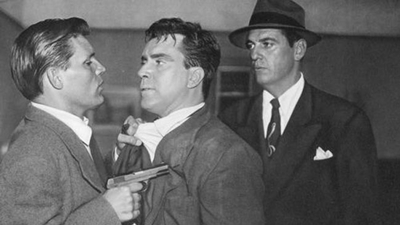
Chester (Neville Brand) gives Frank (Edmond O’Brien) some more trouble. Frank is definitely not having a good day.
I especially like the scenes in which Bigelow leaves the comfort of dancing the rhumba and downing a few drinks in the upscale St. Francis Hotel to visit the noisy, smoky Fisherman club, where he watches a bebop jazz band play its all and chats with “jive-crazy, high-society” Jeannie (Virginia Lee), an elegant blonde who turns out to be a mere red herring.
O’Brien, with his good looks and strapping self-confidence, plays the determined Bigelow as every man’s take-charge fantasy. Britton as Paula is the kind of girl next door that bad-ass femmes fatales played by actresses like Barbara Stanwyck and Joan Bennett would eat for breakfast. Her innocence is nicely countered by a rich array of dastardly, devious characters.
Clarence Greene and Russell Rouse wrote the original screenplay, perhaps inspired by a 1931 German film “Der Mann, der seinen Mörder sucht”/ “Looking For His Murderer” directed by master noir creator Robert Siodmak with writing help from the great Billy Wilder. (In “D.O.A.” Rouse’s name, along with Laszlo and assistant director Marty Moss, appears on the guest register of the Allison Hotel in Los Angeles.)
The movie was remade in 1969 as “Color Me Dead” and in 1988 with Dennis Quaid, Meg Ryan and Charlotte Rampling. The original is the best of the lot. Watch it and you’ll see why.
![bogie and bacall[1]](http://www.filmnoirblonde.com/wp-content/uploads/2012/08/bogie-and-bacall1.jpg)
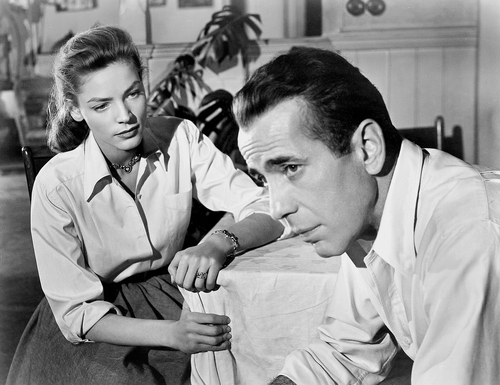
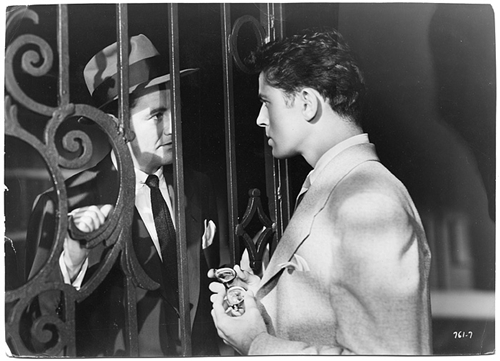





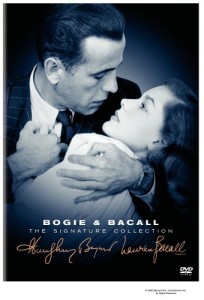
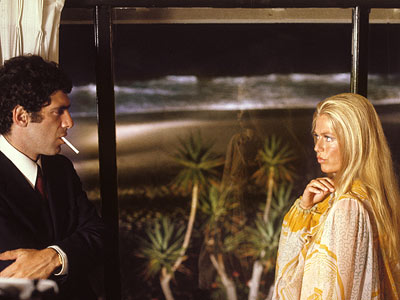

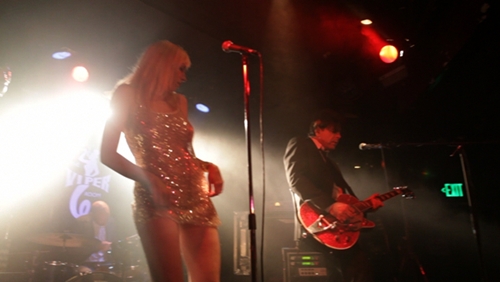
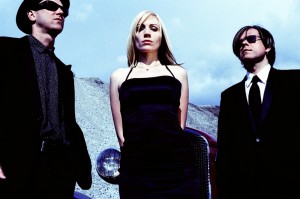
![edmond_obrien[1]](http://www.filmnoirblonde.com/wp-content/uploads/2011/02/edmond_obrien1-150x150.jpg)
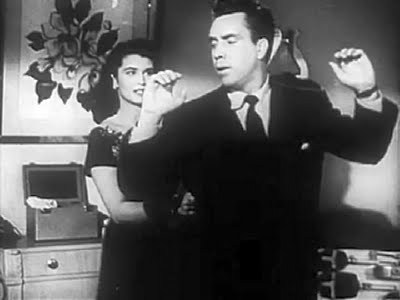





From FNB readers